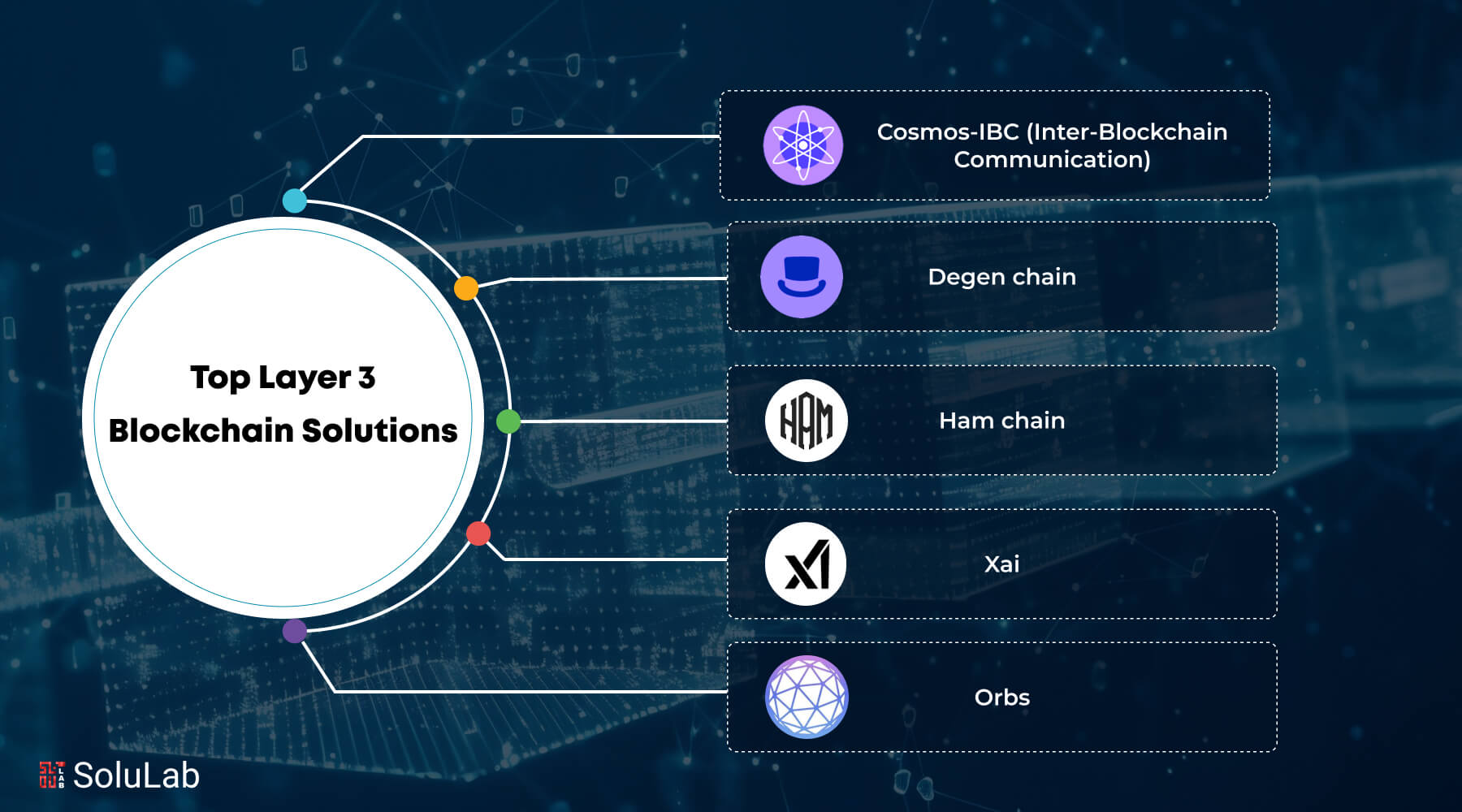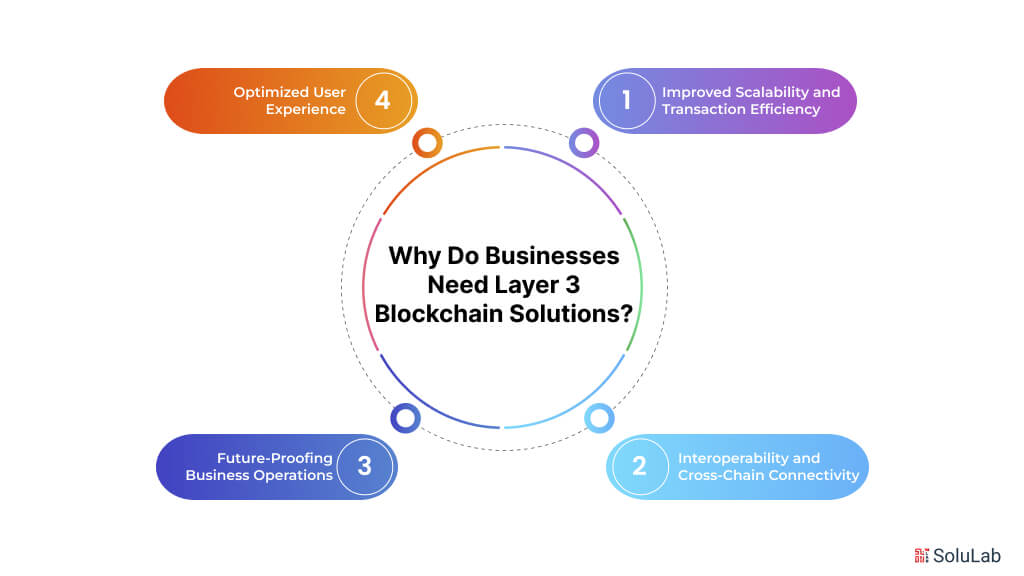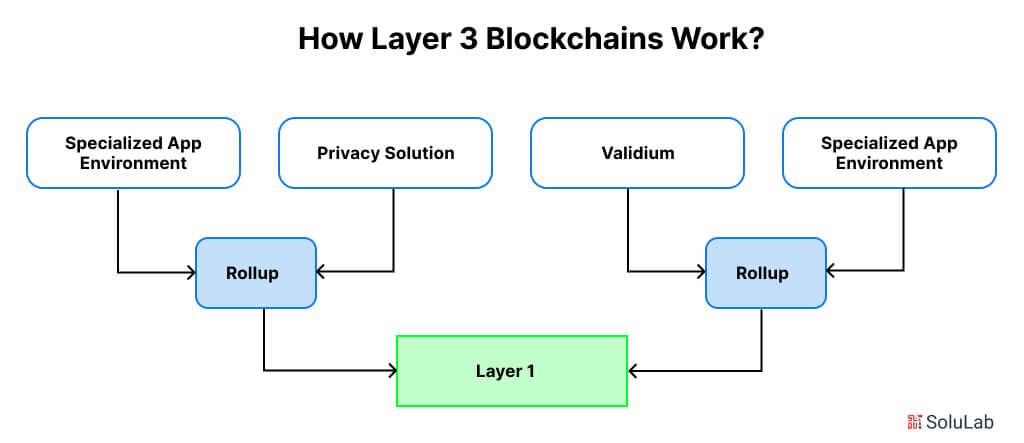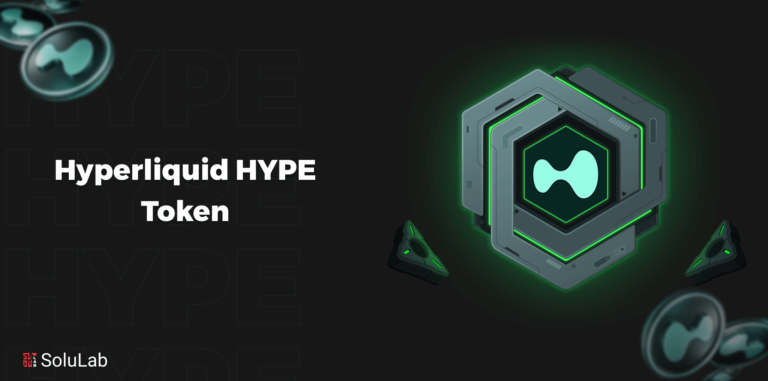
Businesses across industries are facing challenges that existing Layer 1 and Layer 2 solutions struggle to address. From scalability, and high transaction fees to limited customization and poor interoperability, companies are increasingly constrained by the limitations of generalized blockchain infrastructure.
Industries like gaming, finance, healthcare, and supply chain management find it difficult to deliver seamless user experiences, meet regulatory requirements, and innovate in competitive markets. Financial services lead in blockchain adoption, representing 38% of the market, whereas sectors such as healthcare and retail are quickly advancing, propelled by the demand for secure data exchange and effective digital systems.
Designed to tackle pain points like inefficient cross-chain operations, lack of vertical-specific tools, and escalating development costs, these application-specific platforms unlock new possibilities for scalability, interoperability, and tailored performance.
In this blog, we’ll explore the top Layer 3 blockchain, its features, and how it works to help businesses overcome their most critical challenges.
What are Layer 3 Blockchain solutions?
Understanding What are Blockchain Layers? is crucial to know how modern blockchain networks function. Layer 3 blockchains build on existing Layer 1 (like Bitcoin or Ethereum) and Layer 2 (scalability solutions like Lightning Network). These networks are all about making blockchains faster, more interoperable, and tailored for specific uses like decentralized apps (DApps).
The goal behind Layer 3 is to create a secure and scalable blockchain that overcomes the limitations of the earlier two layers through chain abstraction. It connects multiple blockchains and lets them communicate. While Layer 2 focuses on scaling a single blockchain, Layer 3 connects the dots across multiple chains, ensuring they work together smoothly.
Why do Businesses Need Layer 3 Blockchain Solutions?

To stay ahead of the competitive market and see your business grow layer 3 blockchain solutions are mast. Below we’ve listed some reasons why you should go for layer 3 blockchain solutions:
1. Improved Scalability and Transaction Efficiency
Layer 3 solution resolves scalability issues that occur as businesses expand their business operations. Among the top Decentralized Layer 3 Networks, these solutions handle tasks by shifting data processing and computations off the main blockchain or onto a dedicated Layer 3, making transactions faster while keeping security intact. Here’s why businesses need blockchain solutions:
- Decreased congestion on Layer 1 blockchains by offloading complex application logic.
- Quick processing of high-volume transactions, is important for DeFi, e-commerce, and gaming for improved scalability.
This layer 3 blockchain scalability solution enhances the practical applications of blockchain technology for companies handling extensive operations, such as decentralized exchanges or supply chain management in enterprises.
2. Interoperability and Cross-Chain Connectivity
Most businesses now operate in environments that involve multiple blockchains, which requires smooth interactions between different blockchain systems. Layer 3 solution aims for coordination to support cross-chain data sharing and asset transfer.
- Simplify transactions across different blockchain platforms plus, break down operational barriers.
- Improved collaboration within the ecosystem, businesses can connect with customers and partners across multiple chains.
3. Future-Proofing Business Operations
Layer 3 solution is the first step towards Web 3 Dream, where applications and services operate across decentralized platforms. Plus, it enables businesses to remain competitive. Businesses that take advantage of layer 3 protocols position make themselves ahead of their competitors. Here are some advantages they will get:
- Keeping pace with the latest technological advancements.
- Maintaining flexibility to adjust to market needs and blockchain innovations.
4. Optimized User Experience
Layer 3 focuses on user-friendly interfaces and streamlined interactions. This improves the accessibility of blockchain systems for businesses and customers. It makes complex processes intuitive and easy to navigate.
- Higher adoption rates among non-technical users are associated with simplified user interfaces.
- Simplifying the onboarding procedures for partners, clients, and staff.
Top Layer 3 Blockchain Solutions
Here are the top layer 3 blockchain solutions you should know to grow your business:
1. Cosmos-IBC (Inter-Blockchain Communication)
The inter-blockchain communication protocol is an open-source protocol to manage the authentication and transport of data between blockchains. IBC allows various chains to communicate with each other to exchange data, messages, and tokens. Cosmos-IBC is moving toward layer 3 solutions by including rollups and scaling technologies, despite its historical alignment with layer 2 networks.
Cosmic IBC’s scalability and IBC protocol give foundational support for applications that use Layer 3 protocols for enhanced functionality. It combines blockchains across ecosystems like Polkdot and Avalanche while focusing on interconnectivity in the blockchain ecosystem.Cosmoc-IBCs TAO (Transport, Authentication, and Ordering) framework provides secured and ordered packet transfer while setting the groundwork for interoperable blockchain-based applications.
2. Degen Chain
Degen Chain provides layer 3 capabilities to improve the performance of layer 1 and layer 2 infrastructures while serving the gaming and decentralized financial communities. For specialized markets like GameFi and NFTs, it increases transaction speed, lowers costs, and accommodates application-specific chains.
With a gaming ecosystem, Degen Chain integrates smart contract features. It is well-suited for developing platforms like metaverse games and NFT marketplaces that demand high throughput and low latency. Degen Chain, a Layer 3 blockchain project, offers customized solutions for gaming projects that require scalable frameworks and improved user interaction.
3. Ham Chain
Hamchain is designed to augment existing blockchains. It is a developing layer 3 blockchain network that concentrates on privacy and scalability. Ham chain provides off-chain computation and improved privacy layers for enterprise-grade applications. Ham Chain, offers enhanced data privacy and transaction scalability. It also integrates with Layer 1 and Layer 2 blockchains.
It focuses on enterprise use cases needing regulatory compliance and secured transaction environments. Ham Chain is appropriate for the financial services and healthcare industries that value data security while utilizing blockchain technology because of its private transactions and interoperability.
4. Xai
Xai is a Layer 3 blockchain platform designed for optimizing user experience via advanced scalability and interoperability. Xai’s Layer 3 architecture helps complex use cases such as DeFi, decentralized gaming, and supply chain management.
It links the space between blockchain ecosystems, improves capacity, and reduces costs for dApps. Xai focuses on providing tools for developers to combine blockchain functionalities, into mainstream applications without the complexities of Layer 1 or 2 development.
5. Orbs
Orbs is a Layer 3 blockchain platform customized to enterprise solutions. It functions on top of existing blockchains to improve scalability and governance while lowering complications for application developers. Orbs utilizes a hybrid architecture that blends permissioned and decentralized frameworks.
Orbs boosts Layer 1 and 2 functionality by offering decentralized consensus for enterprise applications. Its rare “virtual chain” technology enables the customization of blockchain parameters for specific use cases. Orbs offers scalability and cross-chain operability for DeFi protocols and supply-chain solutions. Moreover, it allows companies to adopt blockchain strategies without compromising performance.
Benefits of Layer 3 Blockchain Solutions
Here are some benefits of layer 3 blockchain solutions:
- Reduced Costs: Layer 3 blockchains can cut the fees on each transaction and make the cost per user and developer interaction with dApps more cost-effective.
- Enhanced Scalability: Layer 3 scaling solutions can decentralize the transaction load from Layer 1 and Layer 2 networks, Layer 3 solutions offer deep scalability as a means of building complex and high-performance dApps.
- Enhanced User Experience: Layer 3 solutions are faster and cheaper. It defines a more user-friendly environment that creates broader adoption for decentralized applications.
- Customization: Layer 3 protocols are precise to developers, they can be optimized for applications as needed.
- Improved Interoperability: Layer 3 solutions let interaction between numerous blockchain networks, enabling dApps to get resources and functionalities from one blockchain network to another.
How Layer 3 Blockchains Work?

Layer-3 blockchains utilize off-chain computation and novel consent methods to obtain scalability and interoperability for decentralized applications.
Layer-3 blockchains incorporate advanced smart contract functionality while utilizing the transactional and security capabilities of L1s and L2s. While Layer 1 vs. Layer 2 solutions each have their distinct advantages – L1s providing the foundational security and L2s offering scalability – Layer 3 takes things further by enabling intricate off-chain computation and settlement while preserving the security and high speed of the blockchain. Plus, it happens all because of layer-2 scaling solutions like state channels and sidechains.
Layer 3 improves interoperability by enabling communication between various blockchains through protocols like inter-blockchain communication (IBC). Inter-blockchain communication (IBC) provides sleek communication between different DApps, containing DeFi and the non-fungible tokens (NFTs) developed on different blockchains.
Through the use of smart contracts, virtual machine environments which are unique within L3 architecture offer the foundation for the execution of numerous DApps. These environments let developers create DApps with refined features that allow the blockchain to execute arbitrary code.
Validium is a tool, used in Layer-3 blockchains to make things faster and cheaper. It uses zero-knowledge proofs to check transactions off the main chain. While it’s great for speeding things up and cutting costs, it relies on validators to keep data safe, so it’s not as secure as Layer-1 blockchains.
Rollups are another smart feature of Layer-3s. They group a bunch of transactions into one neat package, process them off-chain, and then send the results back to Layer 1. This makes things faster and more scalable without losing security.
Layer-3 systems use creative methods like Proof of Stake (PoS) or Delegated Proof of Stake to run. These methods help the network manage more work, use less energy, and stay decentralized and secure. Together, these features make Layer-3 blockchains powerful and efficient.
Future Challenges and the Success of Layer-3 Blockchains
As a growing blockchain development company and blockchain consulting company, you should understand major challenge businesses are facing is the smooth integration and compatibility with layer 1 and layer 2 blockchain architectures. As new technologies and innovations continue to develop, the challenges they bring are also becoming more complex.
Additionally, there is more complexity in developing and overseeing the layer 3 structure. It’s getting difficult to preserve security and decentralize while managing a higher volume of transactions and a growing user base. Layer 3 solutions play a crucial role in maintaining stability and durability by striking a balance between decentralization and performance.
Implementing cross-border regulations for Layer 3 blockchains faces a few challenges. It requires close collaboration with regulators and stakeholders to develop clear and adaptable frameworks that balance compliance with the need for innovation.
The future of Layer 3 solutions will depend on how effectively they address scalability and interoperability issues while delivering tangible improvements to industries and decentralized systems.
Equally, it is important to educate users and developers about the strengths and limitations of Layer 3 technology. Building awareness and understanding will be the key to adopting and encouraging new applications in DeFi and other sectors.
Conclusion
Layer 3 solutions are essential as they surpass the limitations of Layer 1 and Layer 2 while providing improvements in the dApps’ performance. Using layer 3 solutions can take ahead of the competition. It helps you decentralized apps that will be faster, more scalable, and easier for users to use in the future, allowing for widespread usage of the technology across a range of industries.
Layer 3 solutions are essential for maintaining competitiveness in the blockchain market. As businesses hire blockchain developers to build innovative solutions, they recognize that regardless of their industry – whether gaming, finance, healthcare, or supply chain management – Layer 3 solutions are crucial. By tackling industry-specific issues and providing optimized scalability, interoperability, and user experiences, Layer 3 solutions are realizing their full potential.
SoluLab partnered with NovaPay Nexus to develop a cryptocurrency payment platform that enables self-hosted, fee-free digital currency transactions. Our team created a system supporting multiple stores, custom apps, and security features, for businesses to build their cryptocurrency ecosystems.
Are you prepared to investigate Layer 3 Blockchain options for your company? Get in touch with SoluLab today and let us assist you in creating excellent dApps that will differentiate you from the crowded blockchain market.
FAQs
1. Are Layer 3 solutions scalable?
Yes, Layer 3 solutions are designed to be scalable by focusing on specific applications. It reduces network congestion and improves performance. They complement Layer 2 by targeting niche use cases while providing efficiency.
2. How secure are Layer 3 blockchain solutions?
Layer 3 solutions inherit security from Layer 1 and Layer 2 but can vary depending on implementation. Ensuring robust coding practices and audits is key to maintaining security.
3. What industries will benefit the most from Layer 3 blockchains?
Gaming, supply chain, and finance are prime beneficiaries. Layer 3 offers tailored solutions, enabling faster transactions and better scalability for specific industry needs.
4. What challenges do Layer 3 solutions face?
Challenges include interoperability, standardization, and ensuring user adoption. Maintaining a balance between scalability, security, and decentralization is also complex.
5. What are some top Layer 3 solutions expected in 2025?
Expected solutions include gaming-specific chains, decentralized identity platforms, and supply chain networks leveraging Layer 3 for efficiency and customization.






